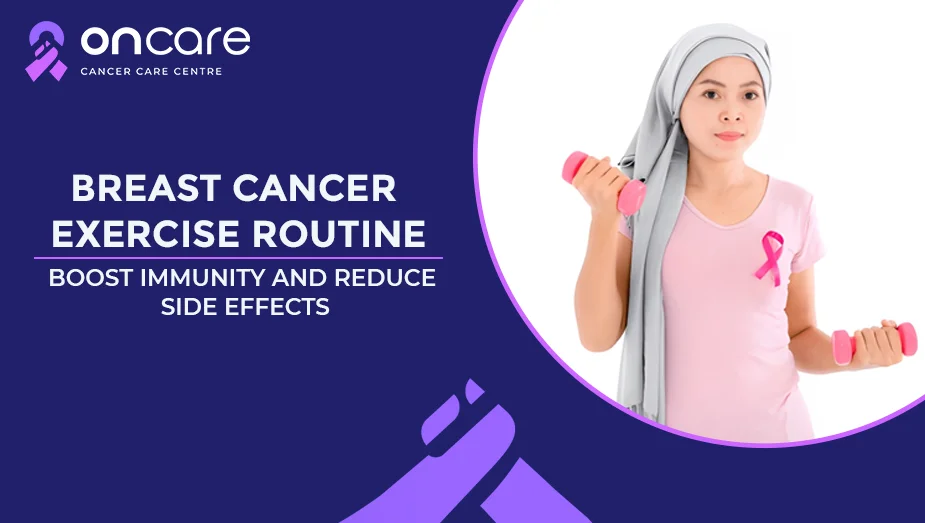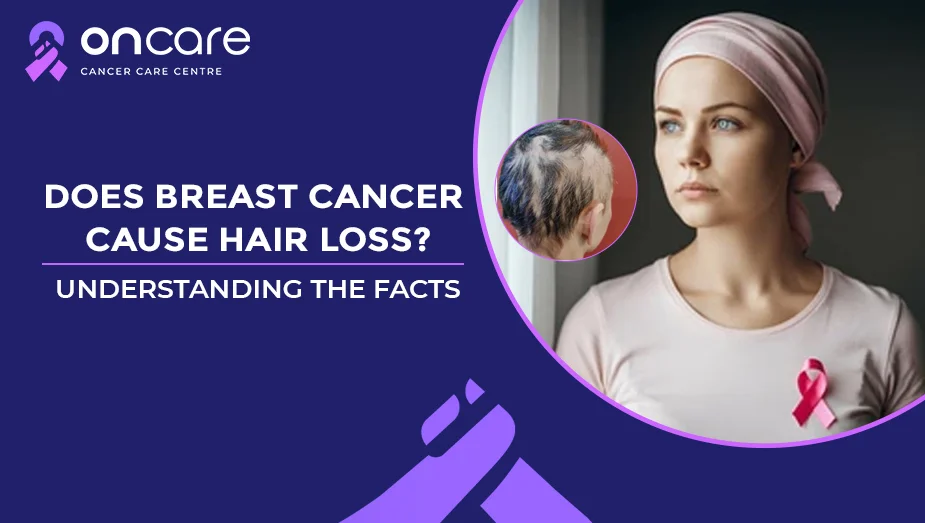Table of Contents
Breast Cancer Exercise Routine: Boost Immunity and Reduce Side Effects

A breast cancer diagnosis brings not only emotional challenges but also causes side effects from treatments like chemotherapy, radiation, and surgery. Fatigue, muscle loss, weight fluctuations, and reduced immunity are common. But here’s the good news: practicing gentle exercise is one of the most powerful, natural ways to help your body heal, strengthen, and recover from the side effects of these treatment-related side effects.
In this blog, we’ll discover more about the exercise routine which helps to boost immunity and reduce treatment-related side effects during breast cancer recovery!
Why does exercise matter during breast cancer recovery?
Practicing exercise during breast cancer treatments is not just about staying fit, but it's a vital part of cancer recovery and long-term health for breast cancer patients and survivors.
Here’s why exercise matters during breast cancer recovery, including:
- This helps to boost immune function by stimulating lymphatic circulation and reducing the effects of inflammation.
- Practicing exercise can reduce fatigue in patients; this is one of the most common treatment side effects.
- Maintain muscle mass and bone strength, which often reduce during the treatment.
- Try to improve mood and reduce anxiety levels by reducing the endorphins as well.
- Patients who practice these gentle exercises help with managing weight, lower the risk of cancer recurrence.
- This helps to enhance mobility after surgery and prevent stiffness or lymphedema (arm swelling)
- Patients who practice a gentle movement often make a big difference when done consistently and safely.
Immune-Boosting Breast Cancer Exercise Routine
Here’s a safe, structured, immune-boosting exercise routine designed to improve strength and flexibility. Whether you are undergoing cancer treatments or recovering from breast cancer treatments, recover afterward.
Warm up (5-10 minutes)
Start with a small warm up and do not put pressure on your body during the warm up.
Here’s how you can start, including:
- Shoulder rolls: Try to perform shoulder rolls 10 times forward and backward.
- Neck stretches: Practice a gentle side -to- side tilts
- Arm circles: Form a small circle to large circles as well.
March past or walk at least 2-3 times at a comfortable pace. If you feel uncomfortable then stop immediately, continue after consulting your doctor.
Strength and resistance (15-20 minutes)
Many studies suggest that practising resistance training can help to maintain muscle mass and bone density.
Here are few exercises that you can follow, including:
- Wall pushups: 2 sets of 10
- Seated bicep curls: 2 sets of 12
- Chair squats: 2 sets of 10 (take support, if you needed)
Some of these exercises can improve your strength without overloading joints or chest areas.
Cardiovascular exercise (2-30 minutes, 3-5 times per week)
An aerobic exercise helps oxygenate the body, support immune system health, and combat fatigue. Including:
Here are some of the options, including:
- Brisk walking (outdoors or treadmill)
- Stationary cycling
- Gentle swimming or aqua aerobics
- Low -impact dancing or yoga flow
You can start with 10-15 minutes per day if you are quite new to exercise after completing your treatments and gradually increase the duration and intensity.
Everything you need to know before starting your physical exercise
If you are completing your breast cancer treatments and planning to practice gentle physical activities, then here are a few things to consider before starting any exercise program, including:
Consult your healthcare provider:
Always consult your oncologist or physiotherapist before starting any types of exercise, especially if you have had surgery, radiation or lymphedema.
Start slow and progress gradually:
If you have decided to start with physical activity, then begin with low-intensity physical movements and increase the duration of your exercise over a period of time.
Listen to your body and its needs:
If you feel like taking a rest, then take that required break and sleep. Many studies have shown that healing takes energy, and overexertion can often delay recovery.
Prioritize your body postures :
Many breast cancer survivors experience tightness around the chest and shoulders. Practicing simple stretching, gentle activities, and deep breathing can restore mobility and calm the nervous system of the patients.
Practice breathing exercises:
If you feel anxious and get nervous quickly, then practice some breathing exercises or meditation as well. Simple yoga activities and meditation can reduce anxiety and calm your nervous system.
Special considerations: Lymphedema and Post-surgery care
If you have had lymph nodes removed after your breast cancer surgeries or radiation therapy, you may be at a risk for lymphedema, which is a swelling developing in the arm or chest area.
Here’s how to exercise safely, including:
- Avoid overexertion or heavy weights in the affected arms.
- Try to wear compression sleeves during physical activities (if recommended).
- Include gentle arm stretching and elevation to promote lymph node
- Watch for signs like swelling, tightness, or discomfort; observe any types of difficulties during your workout session and consult your doctor immediately.
The emotional benefits of practicing physical exercise
If you recently completed your breast cancer treatments or are undergoing cancer treatments, then adopting gentle exercises can help to reclaim your control over body and mind. While many survivors describe their physical activities as empowering, they are a way to reconnect with the patient’s strength and resilience through these mild practices.
Here’s how these practices can improve patients, including:
- Improves sleep quality
- Reduce symptoms of depression and anxiety
- Enhance self-image and body confidence
How does nutrition matter in boosting immunity and reducing side effects?
Here’s how your nutrition and a healthy diet help to boost your immunity and reduce side effects, including:
Combine your gentle exercise routine with a balanced diet which is rich in:
- Antioxidants (berries, leafy greens) to reduce inflammation
- Lean proteins (fish, beans, eggs) to support tissue repair
- Healthy fats (olive oil, avocado, nuts) help to support immune health.
- Drink plenty of water and stay hydrated and flush out toxins
Consult Today
Practicing exercise is not pushing your limits during your cancer treatment journey. These mild, gentle physical exercises help to restore your energy levels and even confidence after breast cancer treatments. Whether you are following a gentle walk, stretching routine, or a mindful yoga session, every bit of physical movement supports your cancer healing journey.
By embracing a physical exercise routine designed especially according to the patient's needs, you can boost immunity, reduce treatment side effects, and rebuild your vitality, one mindful activity at a time.
At Oncare, we offer premium-quality cancer treatments, including advanced cancer surgeries at an affordable price range with an experienced cancer specialist consultation.
If you or any loved ones of yours are diagnosed with cancer, then visit Oncare Cancer Center and book an appointment with our experienced cancer specialist consultation. Get an estimated cost of your cancer treatments today!
Frequently Asked Questions
Yes, in most cases, gentle exercise is considered safe and beneficial during your treatment. It's essential to get your oncologist’s approval. While low impact activities like walking, stretching and yoga can help manage symptoms such as fatigue, boost mood, and support immune health. Try to listen to your body and rest when needed.
After completing surgery, start with light exercises and practice some gentle exercise to restore the mobility in your chest, arms, and shoulders. Always consult your doctor and avoid lifting heavy weights or straining the affected arm, especially if you are at risk for lymphedema.
Here are some of the side effects of reduced while practising these exercises, including:
- Aerobic exercise
- Strength training
- Yoga and meditation
- Breathing exercises
Book an Appointment
Related Blogs

Prognostic Markers for Breast Cancer: What Patients Should Know
Discover more about Prognostic Markers for Breast Cancer and key prognostic markers for breast cancer and why prognostic markers for breast cancer patients!

Top 20 Motivational Breast Cancer Quotes for Patients and Survivors
Explore top 20 motivational quotes for breast cancer patients and survivors and how these quotes can help both patients and survivors move ahead with treatments and follow-ups!

Does Breast Cancer Cause Hair Loss? Understanding the Facts
Discover more about how breast cancer causes hair loss in patients, which cancer treatments affect hair loss in patients, and how to manage and cope with hair loss!

Triple Test in Breast Cancer: Combining Exams, Imaging, and Biopsy
Discover more about the triple test in breast cancer, types of breast biopsies, the power of combining all these three tests, and what to expect during these treatments!

